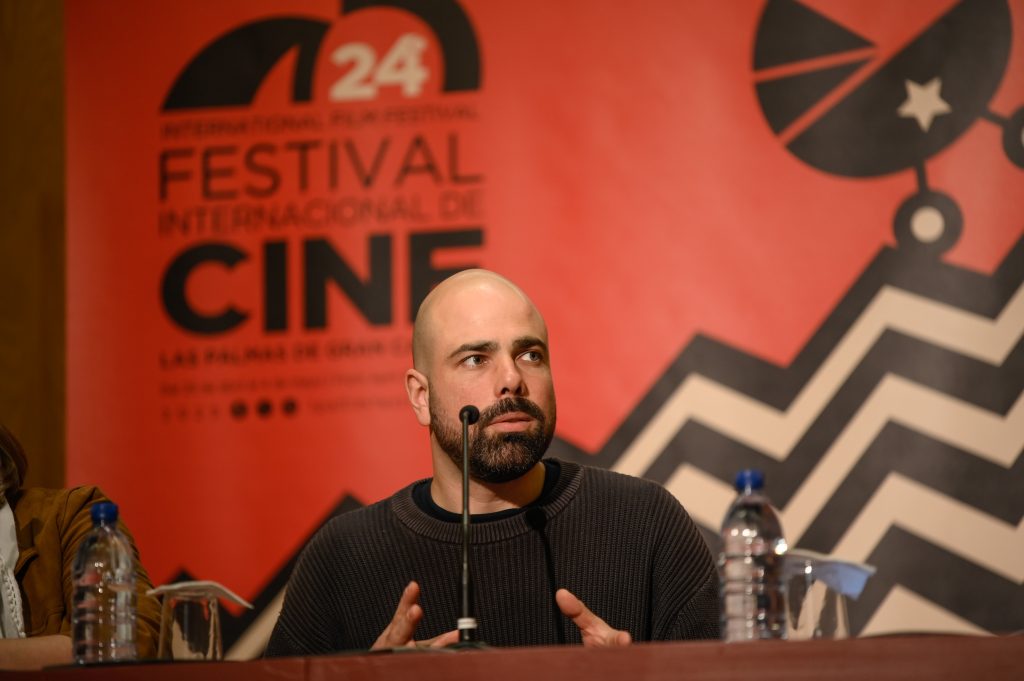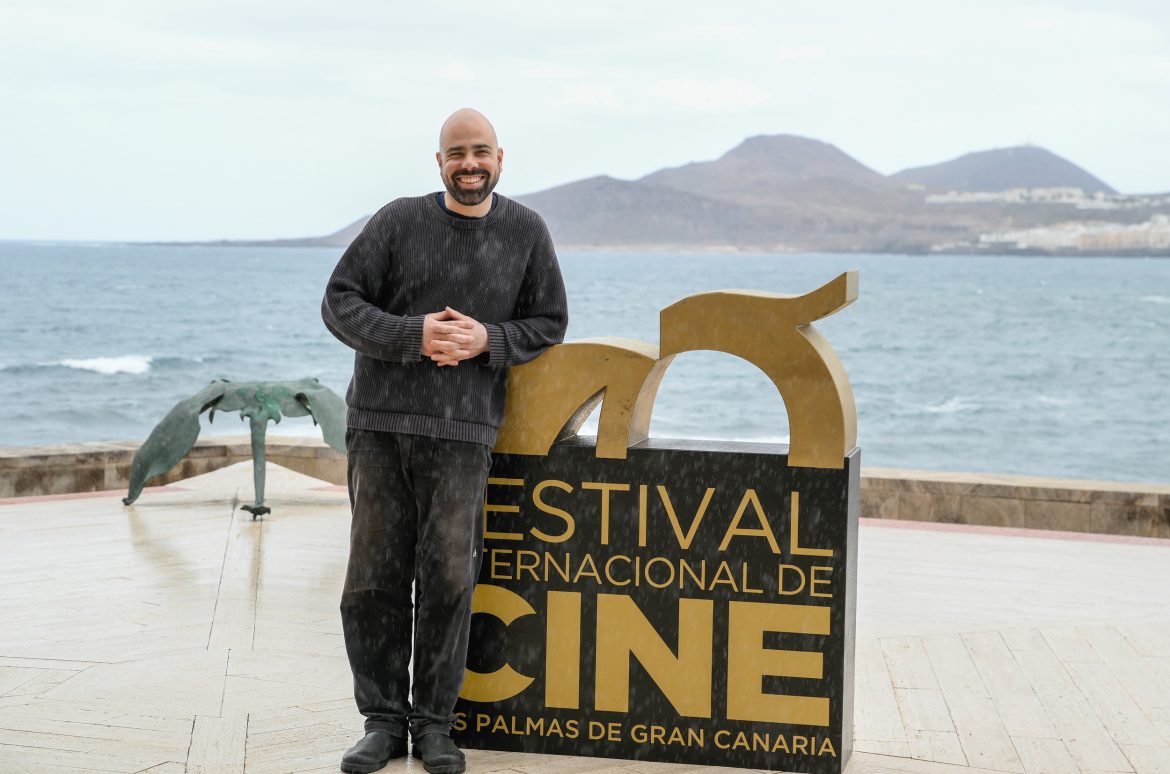- The Georgian filmmaker, who received an award at Locarno, has created a singular comedy with non-professional actors by playing with the genre’s boundaries

04.29.2025. Alfredo Kraus Auditorium. Tato Kotetishvili. Las Palmas de Gran Canaria. Pictures: Eros Santana.
Las Palmas de Gran Canaria, Tuesday, April 29, 2025.- Tato Kotetishvili debuts as a film director with Holy Electricity, one of the most exotic works competing in the Las Palmas de Gran Canaria International Film Festival’s Official Section. The Georgian cinematographer, who has previously worked in his country’s cinema industry for Levan Koguashvili (Blind Dates, 2014) and Uta Beria (Negative Numbers, 2014), as well as for Ukrainian filmmaker Tonya Noyabrova (Hero of My Time, 2018), won the Golden Leopard – Filmmakers of the Present Award at the 2024 Locarno. A recognition to this irreverent comedy that turns into a docudrama: the crazy adventure of two cousins who work selling neon crucifixes in Tbilisi’s suburbs.
Kotetishvili is also responsible for the script (co-written with Irine Jordania and Nutsa Tsikaridze) and the cinematography of a piece he has co-produced, too. Holy Electricity has already been shown at festivals such as Luxembourg, Rotterdam, Sarajevo, Tallin or Goteborg, where it has received good reviews.
As Kotetishvili revealed, he found inspiration for his film in his own environment, the Georgian capital: “Crosses are probably the most important symbol in Georgia because it’s a very religious Christian country. Our flag,” he explained, “even has five crosses, and in the film, well, you’ll see they are always present.” Regarding this iconographic background, the Georgian filmmaker thinks it is more important that people can “interpret it differently, which would be very nice.”
In fact, he hopes that everyone “can find their own meaning,” regardless of other possible style-related aspirations. Something he intentionally decided to overlook as a cinematographer in order to focus his attention on directing.
“I tried to adapt the process so that I could give all my attention to the actors,” he pointed out. “One of the reasons that it’s all so static is because of the way I was shooting. Since I was also the director, once I set the frame, I could focus all my attention on the characters. But it wasn’t just this: because there was improvisation, I didn’t know exactly what I would cut.” Besides, the filmmaker continued, “we shot with natural light because for a cinematographer it takes a lot of attention and energy to communicate with the electricians or gaffers. It makes it simpler when you are on natural light.”
Kotetishvili tried to film his story “as if it were a sort of documentary.” But the truth is that it is not, at least in a conventional way. What appears on screen is “a dream, a little bit what they [the actors themselves, as people] would’ve liked,” although it also reflects somehow what is happening in the real world. For the filmmaker, “the combination worked pretty well, I think.”
As for the difficulty of filming with non-professional actors, Kotetishvili said that “when we were writing the script we already knew they’d be non-professional actors, real people, and when we’d find them we would adapt the script to them, so they could bring their personalities to the film.”
What’s more, one of his priorities was to “make them feel very comfortable on the set so they wouldn’t be afraid to try new things. We always had enough time to improvise, try and, if not, do things differently.”
Kotetishvili tried to look for ‘interesting’ secondary characters, a decision that populated the film with different textures and personalities. He also didn’t attempt to explain or reflect everything because, as he noted, he likes to leave enough room for the viewers’ imagination. “Yes,” he claimed, “there are many aspects that are left there in a subtle or latent form.”
The soundtrack acquired a key role in the film, too. The Georgian filmmaker explained that “we started shooting the scenes, and once the filming ended, we began to choose most of the music.” Thus, several underground compositions by Georgian artist Vago became important: he had some of them already, but he also made some more for Kotetishvili’s film. Furthermore, the director included street musicians “you could hear in the metro and other places” in some scenes, which gives an extra layer of personality to his work.
Holy Electricity will be screened for the last time tomorrow, April 30, at 6:00 p.m. at Cine Yelmo Las Arenas Screen 7.
Partners, sponsors and collaborators of the 24 FICLPGC
The Las Palmas de Gran Canaria International Film Festival, organized by the Culture area of the Gran-Canarian capital’s City Council through Promoción de la Ciudad de Las Palmas de Gran Canaria, has received public assistance by the ICAA [Institute of Cinematography and Audiovisual Arts], the Visitors’ Program for the Internationalization of Spanish Culture (PICE), of the Spanish Public Agency for Cultural Action (AC/E), as well as public support from Promotur Turismo Islas Canarias.
Among the Festival’s collaborators we may find Fundación Auditorio Teatro, Cines Yelmo, Las Arenas Shopping Center and Hotel Cristina by Tigotan, places which also function as venues or hold activities of the film event; as well as other institutions and companies such as Sagulpa, Toyota, Royal Bliss, Fuze Tea, Coca Cola, Sholeo Lodge, Audiovisuales Canarias, Music Library &SFX, Blackout Films and International Bach Festival. Likewise, its market, MECAS, has been possible thanks to the sponsorship of the Gran Canaria Film Commission-Sociedad de Promoción Económica de Gran Canaria and the support of Proexca.
The University of Las Palmas de Gran Canaria, the Mid Atlantic University, Digital 104, the Audiovisual Cluster of the Canary Islands, the Association of Women Filmmakers and Audiovisual Media CIMA, the Cartagena International Film Festival, the Gijón International Film Festival, the Barcelona Independent Film Festival, the Tres Puertos Laboratory, Barcelona’s ESCAC, and Very Good Script, Freak World and Fimucité are also collaborators.
Share this Post

